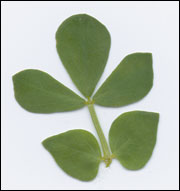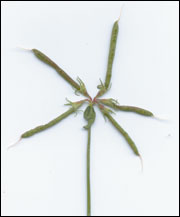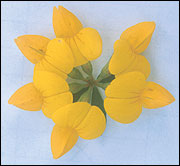Birdsfoot trefoil (Lotus corniculatus L.)
Legumes
Birdsfoot trefoil is a short-lived perennial legume capable of producing high-quality forage on soils where other legumes do not survive. Although it generally yields less than red clover and alfalfa when cut for hay, it often gives better performance than these legumes when grown in a grass/legume pasture. Unlike many other perennial legumes, birdsfoot trefoil does not cause bloat in cattle. However, it does not tolerate continuous grazing or frequent haying. It is also prone to a number of diseases and pests that make management for reseeding essential. Although birdsfoot trefoil may grow statewide, it is best adapted to northern Missouri.
 Birdsfoot trefoil
Birdsfoot trefoil
 Yield distribution of birdsfoot trefoil in Missouri.
Yield distribution of birdsfoot trefoil in Missouri.
- Origin: Mediterranean basin
- Adaptation to Missouri: Statewide but persists better in northern Missouri.
- Growth habit: Semi-erect to prostrate, short-lived perennial.
- Leaf: Pentafoliolate, alternately on short stalks with two leaflets at the petiole base resembling stipules, pointed leaflets are mainly glabrous and not serrated.
- Stems: Decumbent, with stems arising from the crown, often branched.
- Stipules: Glandiform, tiny, dark.
- Flowers: Yellow, may be tinged with orange or red, borne in clusters of 4 to 8 at the end of the flower stalk.
- Fertilization: No N needed if nodulated. Maintain 30 lb P/acre and 250 lb K/acre.
- Timing of production: 70 percent of annual production between April 1 and June 30.
- When to begin grazing: Often based on the height of the grass in the mixture. Few if any pure stands exist.
- When to cut for hay: Not normally cut for hay unless it is mixed with a companion grass. Harvest based on the maturity of the grass.
- Lowest cutting or grazing height: 4 inches
- Fall management: Avoid severe grazing from Sept. 15 until the first hard killing frost.


